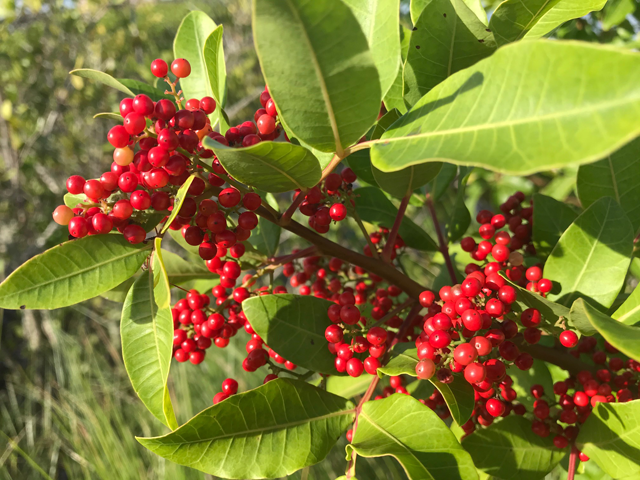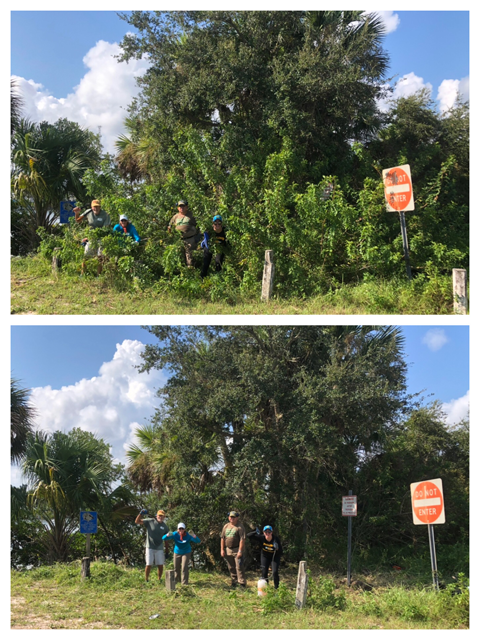By Lisa D. Mickey
During the holiday season here in Florida, you might be tempted to deck the halls with the beautiful red berries from a plant often called “Florida Holly” or the “Christmasberry tree.”
But take heed: the plant that bears these bright red berries, the Brazilian pepper tree, is more closely related to poison ivy or poison oak than to Florida hollies. Contact with the sap from this tree may result in an itchy allergic skin reaction or even respiratory problems for some.
In fact, there is nothing jolly about this faux Florida holly, which produces bright, red berries each year around the December holiday season. There are actually 15 native holly trees in Florida, but Brazilian pepper is not one of them.
So how did they get here?
Brazilian Pepper (Schinus terebinthifolius) is an evergreen tree that is native to Brazil and Paraguay and typically grows 15-30 feet in height. The plant was introduced in the United States in the mid-1800s as an ornamental plant and was widely distributed by the residential shrub industry in the 1940s.
By the 1950s, this plant was spreading beyond the lawns on which it was planted. Brazilian pepper now covers an estimated area of more than 700,000 acres in Florida and is regulated by the Florida Department of Environmental Protection as a Category I invasive species.
According to the University of Florida’s website, Brazilian pepper is an aggressive and widely spread invasive plant that “produces a dense canopy that shades out all other plants and provides a very poor habitat for native species.”
Just like another invasive species, Australian pine, Brazilian pepper is known to invade disturbed sites, such as spoil islands or mosquito ditches on the Indian River Lagoon. Land that has been moved, resulting in elevation changes, provides an ideal setting for this prolific seed-producing plant.
Quite a few animal species, such as the raccoon and opossum, eat the berries, as do birds, such as American robins, cedar waxwings, northern mockingbirds and gray catbirds. When native creatures gobble the berries, the remnants of their dining become scattered plantings of future trees.
The state of Florida, as well as private land owners, spend hundreds of thousands of dollars each year to eradicate this hard-to-kill plant. Brazilian pepper has had much the same effect in Florida that the invasive kudzu plant has had throughout the American Southeast. Kudzu was brought from Japan to the United States in the 1950s as a ground-cover option for erosion control, and like Brazilian pepper, it has aggressively covered the landscape, overtaking native species and altering natural habitats.
And while the beauty of the Brazilian pepper berry belies its sinister occupation in Florida’s coastal ecosystem, this plant does have at least two redeeming qualities: it yields an abundance of nectar used by honey bees to produce the tasty Brazilian pepper honey; and it may potentially help fight antibiotic resistance.
Several years ago, medical ethnobotany scientists at Emory University explored South American botanical folk medicines for wounds and infections. They were intrigued to learn that traditional healers in the Amazon region had used the Brazilian pepper plant to treat skin and soft tissue infections for centuries.
This discovery resulted in research stateside and a scientific publication in 2017 that documented how they had found an extract from the Brazilian pepper tree can “disrupt signaling” between MRSA (Methicillin-Resistant Staphylococcus Aureus) bacteria cells.
When the MRSA cells could not connect, the study determined the cells were “unable to release toxins that cause serious infection, essentially disarming them.” MRSA kills tens of thousands of people each year.
Scientists in the study also used extracts from the bark of the Brazilian pepper tree to successfully kill several pathogens.
Who would have ever known that the maligned plant that keeps Florida weed whackers in constant use could potentially be so beneficial?
But back to your holiday decorating.
Maybe a string of holiday lights in your palm tree or a wreath decorated with seashells and pink plastic flamingos will be the answer this year.
Whatever you decide, just remember, those pretty red berries of the Brazilian pepper are not holiday holly, and if you are allergic to them, your festive season will be far from jolly.




Follow Us!